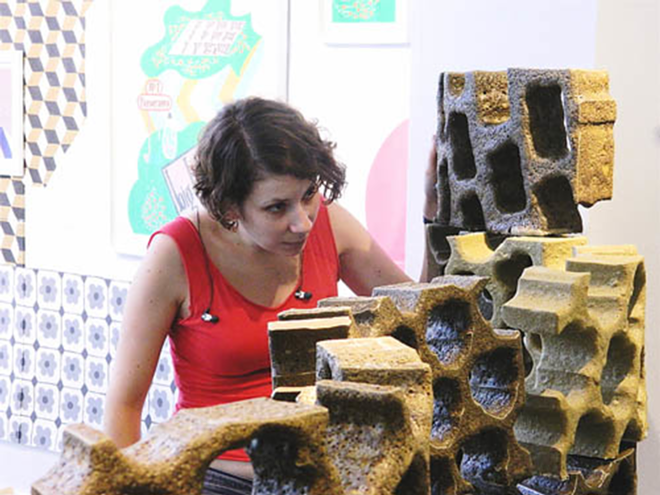
The sweltering warehouse near downtown St. Pete that houses artist Catherine Woods's studio could hardly be a more improbable site for her latest creations — luminous sculptures of layered glass designed to evoke the glimmering surface of water. Lean one way to look at "Water DNA," for instance, a rounded strip of translucent glass bands, and you'll see a certain formation of stripes in various blues and greens; lean the other way, and a different array of color appears through layers of fused glass.
Last week, when I visited Woods's studio — a space she shares with her husband and fellow artist Mark Aeling — you could fry a proverbial egg on the pavement outside. Inside the hot warehouse, Woods was hard at work putting the finishing touches on her series of cool glass sculptures, now on view in PatternPlay, an exhibition at Florida Craftsman, Inc.
Organized by Jorge Vidal, an independent curator who has worked for the Morean Arts Center and the Museum of Fine Arts, the show brings together five artists from the Bay area and beyond whose works provide an occasion to marvel at feats of pattern composition in media as diverse as glass, wood grain, fired clay, paper and fabric.
Not all of Woods's sculptures are designed to recall water — one of the wall-mounted pieces produces a gorgeous plaid effect when stripes intersect — but most of them share a cooling palette of blues, greens, gold and violet inspired by the Caribbean. Working with ultra-thin strips of the colored glass, Woods pieces together layers of stripes (and then fires the glass) until she achieves the desired effect — a pattern of colored bands that seems to move and transform as the viewer regards the piece.
"There's a lot of R&D," she admits.
The fun of PatternPlay stems from the breadth and quality of work built around a seemingly simple idea: to celebrate the artistry, perhaps better described as the science, of pattern. Along with Woods's glass marvels, the exhibit includes the painstakingly composed, Pop Art-influenced collages of Miami-based artist Michelle Weinberg and work by Jennifer Cecere, a New York-based artist who makes mandala-esque sculptures of fabric and lace, sometimes incorporating portraits of women into the pieces. Close followers of the Bay area art scene will recognize the work of Cosme Herrera, an artist from Tampa who now lives and works in New York. His veneer "paintings" — landscapes of trees and human figures rendered in wood veneers of contrasting grains and colors — continue to evolve. The ones included in PatternPlay, like "Logos VIII," have an unsettlingly ominous quality; within their bleak expanses, it's difficult to discern whether the humans mean to help or harm the environment to which they belong.
The centerpiece of the show in a literal sense is Sarah Gross's undulating ceramic wall, which bisects Florida Craftsmen's gallery. Stretched between two white pillars in the center of the room, rows of perforated ceramic "bricks" stacked atop each other make up the wall. When I visited the space to watch Gross build the installation, she was well on her way to stacking the bark-brown and mustard-colored blocks into a wall nearly ten feet tall at its highest point. Sunlight peeked through trefoil, quatrefoil and rectangular patterns cut into the bricks.
Gross, who lives in Lawrence, Kan., estimates that more than a ton of raw clay went into making the piece, which is why she crafted it largely from recycled clay used and discarded in beginning ceramics classes. After forming the clay into thick bricks with a slight arc to their shape, Gross cut out the geometric patterns with a knife. Varying the size and density of the pattern on each brick, she ended up with dozens of pieces of a ceramic wall, each possessing a snowflake-like uniqueness. When stacked, the result is a kind of organic, avowedly handmade version of the densely patterned screens and tile decoration characteristic of Islamic architecture, or a ceramic meditation on honeycomb. In St. Pete, Gross says, people see the shape of coral in the piece, presumably because of proximity to the ocean. Though her color palette usually runs closer to the bright pinks and reds of coral, Gross opted for more muted tones for this project. The bubbly glaze that coats her bricks is intended to evoke stone, moss, rust and metal — giving the installation the aura of a chance outcropping of nature's subtle patterns.
"It says more because it's kind of quiet," Gross explains.

